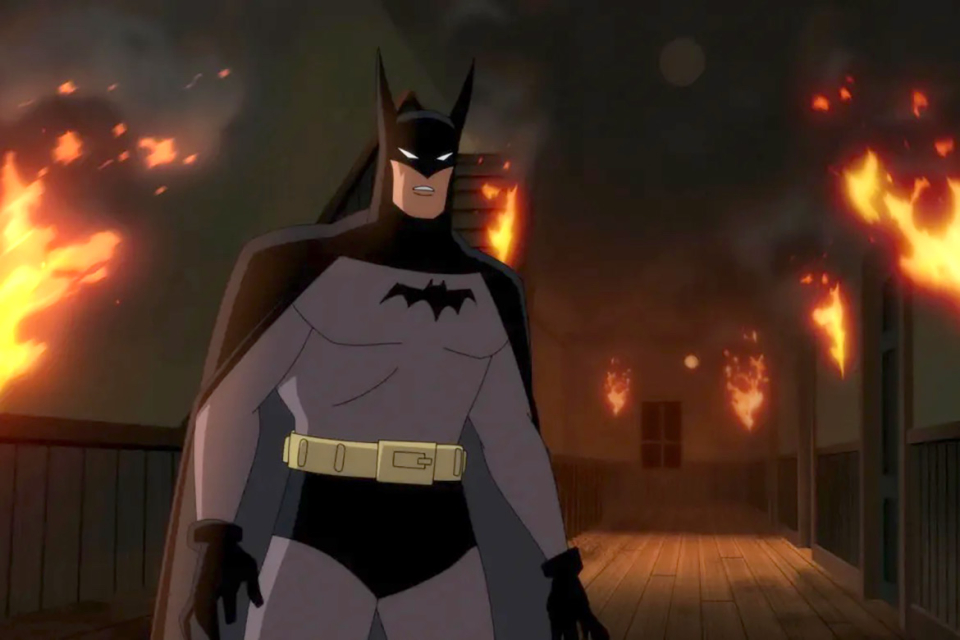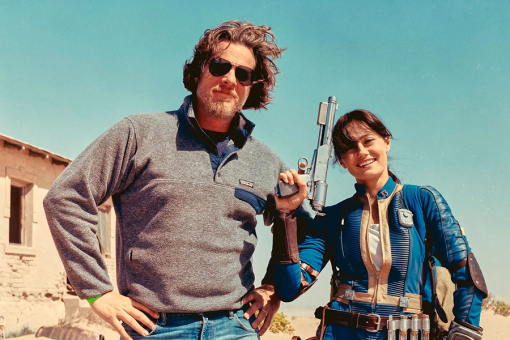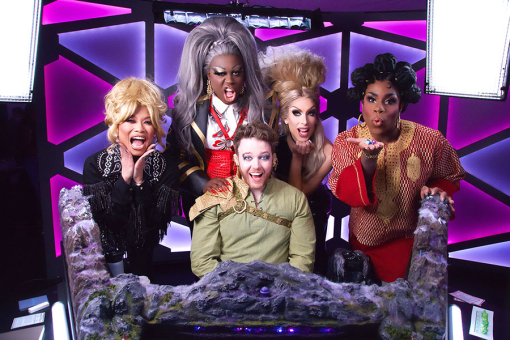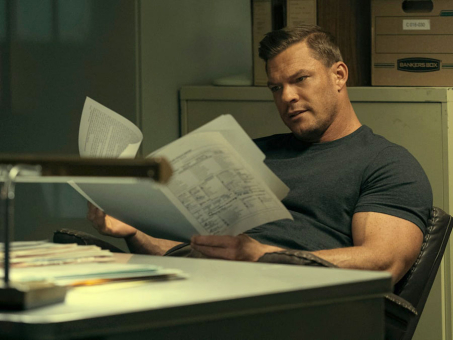Bruce Timm and James Tucker have devoted much of their careers to bringing Batman to television, often working together over the years, and if we listed all of their Bat-credits in this intro, well, it would be — no exaggeration — a mile long.
But Timm is undoubtedly most well-known as the creator of the Emmy-winning Batman: The Animated Series, known as BTAS. The mid-‘90s Fox Kids series broke ground by delivering a darker depiction of Gotham’s resident superhero and introducing the character of Harley Quinn to the Batman universe. It’s been nearly 30 years since it went off the air, but, to this day, BTAS is hailed by fans of the Dark Knight, including Tucker, as the ultimate Batman show.
Tucker is best known as creator of another standout in the Batman TV canon — Cartoon Network’s Batman: The Brave and the Bold, an animated series from the aughts that had a lighter tone and celebrated the beloved character’s comic book roots.
Now, Timm and Tucker are combining their years of Bat-experience on a new project — Prime Video’s Batman: Caped Crusader. All 10 episodes of season one drop on August 1. Created by Bruce Timm and executive produced by Timm, J.J. Abrams and Matt Reeves (director of the 2022 blockbuster The Batman and its upcoming sequel), Caped Crusader is set in the 1940s and has an unabashedly noir vibe. Bruce Wayne’s Batman is on a one-man mission to mete out justice in a Gotham City overrun by criminals, but his heroics lead to unforeseen ramifications.
Here, Timm, who is also serving as showrunner, and Tucker, the show’s coexecutive producer, take part in a Bat-chat about how this new chapter in Batman’s story came to fruition.
Television Academy: What’s the origin story behind your latest reimagining of Batman?
Bruce Timm: Well, I kind of blame this show on James, because my bosses were interested in going back and revisiting BTAS. They pitched it to me, and I was like, “I am so not interested.” I didn’t want to have to compete with everybody’s memory of that show, because a lot of people grew up with it, and that’s their favorite version of Batman, which is awesome. Another thing is, I didn’t really feel like there was much more we could do with that version of the characters. But James and I had worked on a series called Justice League Unlimited, which was one of my favorite shows I’ve ever worked on, and that was a show that basically had Batman, Superman, Wonder Woman and all those characters teaming up with every character in the DC universe. So I thought there were more possibilities and potential to do different stories. I suggested that to my bosses, and they went, “Well, we’re not as excited about that. But yeah, if you want to talk to James about it, if you want to work with James on it, that’d be great.”
So I called James up and told him what prompted the whole thing, and we started talking about Justice League, and then he kept swinging the conversation back to BTAS.
Why do you think that is?
Timm: He had an ulterior motive for it. He didn’t tell me at the time, but it was like, “I hear what you’re saying, but if you had a chance to go back, aren’t there things you wanted to do with the show that you couldn’t do back then, either because of broadcast standards and practices, or because the show evolved away from where you originally did it?” And the more we talked about it, it was like, “Yeah, there was a ton of stuff, actually.” My original idea was to make [BTAS] set more deliberately in the 1940s, not just a ‘40s-ish world like Tim Burton did. I’d really love to have seen it with rotary dial phones and no computers and all that stuff. So, the more we started talking about [doing a show more in the vein of BTAS], by the end of that conversation, I was all in on the idea. Then nothing really happened for a while. James was working on a couple of different projects, and I had some direct-to-video movies I was working on. It kind of sat on the backburner for a while.
What ultimately got it off the backburner for you?
Timm: My bosses called me up a couple years later, and they said, “J.J. Abrams and Matt Reeves would be interested in executive-producing a new Batman show with you,” and I went, “Okay, that’s awesome.” Then I thought, “I would really like to make this show with James.” It was his idea in the first place, and also, I knew that James would be the guy to design this show — he ended up designing almost all of the characters. And he didn’t get to work on the original BTAS.
James Tucker: I started [my career] when BTAS was in production. I was in Chicago subcontracting at a studio that was doing the first season of Animaniacs at the time, but I knew BTAS was happening. In fact, we got some test footage on a VHS from BTAS, I think it was from the episode “On Leather Wings.” I saw it, and my head about blew off. The studio I was at was under consideration to work on an episode, but my boss, the head of the studio, was like, “No, we can’t do that stuff.” It was just too advanced. It wasn’t funny animal stuff. So I thought, “There goes my opportunity.” And I just went on and made Animaniacs. But I always thought, “That’s what I really need to do, where I really need to be.”
Then I ended up coming out to L.A. and getting a job on Superman: The Animated Series — interviewing with Bruce and getting that job after BTAS had ended. And we ended up doing more Batman later, but it was different in tone. And fast forward [to Caped Crusader] — wishes do come true, kids.
I love that for you! Can you tell me more about the tone of this new show?
Timm: When we started talking about this new show, we said, “We want to explore the idea of Batman being this really spooky, kind of odd, kind of damaged human being who doesn’t relate to people very well.” But at the same time, we didn’t want the show to be depressing. We wanted each episode to be enjoyable to watch. So that’s the goal we set for ourselves, and soon we’ll see if we succeeded at that.
The show is in color, but the opening title sequence is made up of stunning black-and-white animation. Is that something you planned to do from the beginning, or is that an idea that came to you as you moved through the creation of the series?
Timm: That came about because we were trying a bunch of different things for the title sequence, and we tried a lot of different things that weren’t really working, and I don’t remember whose idea it was to do it in black and white, but as soon as we saw what [art director] Matt Girardi came up with for the treatment for us, not just the black and white but the extra grain and all of that, we were just like, “Oh, man, that’s amazing.”
I literally clapped when I saw The Penguin was a woman and heard Minnie Driver doing her voice. It was an unexpected and wonderful surprise. Why did you make that choice?
Timm: James and I were talking about the overview of the show, and we said, “One of the problems with Batman, as he is, is there’s a lack of good villains. You’ve got Catwoman, you’ve got Poison Ivy, you’ve got Harley Quinn. But it would be really good to have more female villains.” And off the top of my head, I said, “We never really could figure out exactly what to do with The Penguin, what the gimmick for The Penguin would be. What if we gender-flip The Penguin?”
Tucker: When he said “Maybe we can gender-flip Penguin,” I just got this flood of ideas. I was thinking of Marlene Dietrich in her tuxedo and Cabaret the musical and the art form of cabaret, and I just started drawing. I instantly got a flood of ideas. Also, I was thinking a little bit of Harvey Fierstein and Hairspray and Divine. It just was like I knew instantly what it could be.
Well, again, it was a fun reveal. As a fan, you think you know so much about Batman’s world, and then you see something you didn’t expect.
Tucker: That was the mission statement for the show in general: to do something that harkened back to the original, but flip it. We’ve seen live-action and animated versions of Batman on TV.
What advantages do you have when you bring Batman to life through animation?
Timm: Not to knock any of the live-action Batman movies — a lot of them are really good. But superhero movies in general, at least for the longest time, they tended to work better in animation than in live-action movies because there was a limitation in the special effects, as well as with costuming the characters. You could get away with Adam West wearing a cloth costume back in the day, and it was kind of silly. But everybody was in on the joke. In animation, they can look much more like their comic book counterparts and be animated convincingly. It’s like Batman throwing a rope across the street and swinging across the chasm of the streets is more convincing in animation, or at least easier to accomplish. Obviously, since we did BTAS, effects technology has really caught up, and the same thing with the costuming.
Tucker: And even with that said, they’re using animation [to enhance] the live action to make it more believable.
Timm: I think hand-drawn animation is much closer in spirit to the comic books themselves, which are also hand-drawn. It’s not a million miles away.
Tucker: Animation rules. It’s the best. Like Bruce says, it’s the most one-to-one comparison to comics you can get, and everything else is one more step removed, and that makes it harder for them to pull off the believability. It’s kind of an obvious thing to do superheroes in animation.
Batman: Caped Crusader is now streaming on Prime Video.













